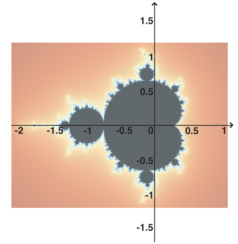mandel
mandel — Mandelbrot set
Description
Returns the number of iterations corresponding to a given point of complex plane by applying the Mandelbrot set formula.
Performance
kiter - number of iterations
koutrig - output trigger signal
ktrig - input trigger signal
kx, ky - coordinates of a given point belonging to the complex plane
kmaxIter - maximum iterations allowed
mandel is an opcode that allows the use of the Mandelbrot set formula to generate an output that can be applied to any musical (or non-musical) parameter. It has two output arguments: kiter, that contains the iteration number of a given point, and koutrig, that generates a trigger 'bang' each time kiter changes. A new number of iterations is evaluated only when ktrig is set to a non-zero value. The coordinates of the complex plane are set in kx and ky, while kmaxIter contains the maximum number of iterations. Output values, which are integer numbers, can be mapped in any sorts of ways by the composer.

Examples
Here is an example of the mandel opcode. It uses the file mandel.csd.
Example 571. Example of the mandel opcode.
See the sections Real-time Audio and Command Line Flags for more information on using command line flags.
<CsoundSynthesizer> <CsOptions> ; Select audio/midi flags here according to platform -odac ;;;realtime audio out ;-iadc ;;;uncomment -iadc if realtime audio input is needed too ; For Non-realtime ouput leave only the line below: ; -o mandel.wav -W ;;; for file output any platform </CsOptions> <CsInstruments> ; By Stefano Cucchi 2021 sr = 44100 ksmps = 32 nchnls = 2 0dbfs = 1 instr 1 ; FM instrument ksig oscil 1, 4 ; create a trigger signal ktrig trigger ksig, 0, 2 kx linseg p8, p3, p9 ; in the range -1 1 ky linseg p6, p3, p7 ; in the range -1 1 kmaxIter linseg p4, p3*0.5, p5, p3*0.5, p4 kiter, koutrig mandel ktrig, kx, ky, kmaxIter printks2 "maximum iterations = %d\n", kiter ; show them asig foscili 0.3, 1, 440, kiter, 10, 1 ; use number of iterations to modulate outs asig, asig endin instr 2 ; grain instrument ksig oscil 1, 100 ; create a trigger signal ktrig trigger ksig, 0, 2 kx linseg p8, p3, p9 ; in the range -1 1 ky linseg p6, p3, p7 ; in the range -1 1 kmaxIter linseg p4, p3*0.5, p5, p3*0.5, p4 kiter, koutrig mandel ktrig, kx, ky, kmaxIter printks2 "maximum iterations = %d\n", kiter ; show them insnd = 1 ibasfrq = 44100 / ftlen(insnd) ; use original sample rate of insnd file kamp = .8 kpitch = 1 kdens = kiter kaoff line 0, p3, .1 kpoff = 0 kgdur =.002 imaxgdur = .5 asig grain kamp, kpitch, kdens, kaoff, kpoff, kgdur, insnd, 1, imaxgdur, 0.0 outs asig, asig endin </CsInstruments> <CsScore> f 1 0 4096 10 1 1 0 1 ; sinoid wave (instr 1) f5 0 512 20 2 ; Hanning window (instr 2) ; start end X1 X2 Y1 Y2 i 1 0 10 110 2000 -1 1 -1 1 ; start end X1 X2 Y1 Y2 i 2 11 10 120 1 0 1 -1 0 e </CsScore> </CsoundSynthesizer>
Two musical examples featuring the mandel opcode: Mandel_Daughtrey.csd by Scott Daughtrey, and Mandel_Gogins.csd by Michael Gogins.